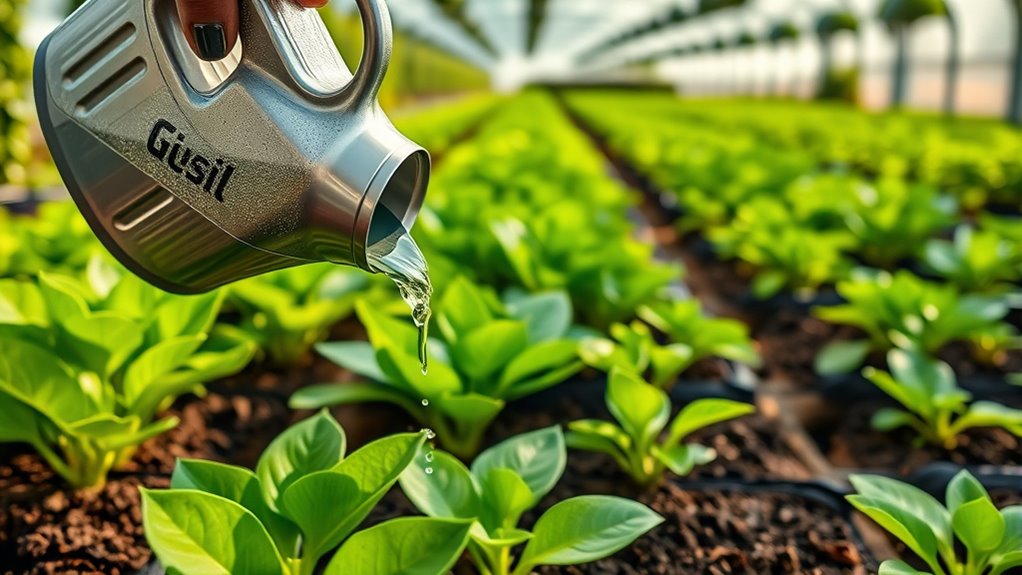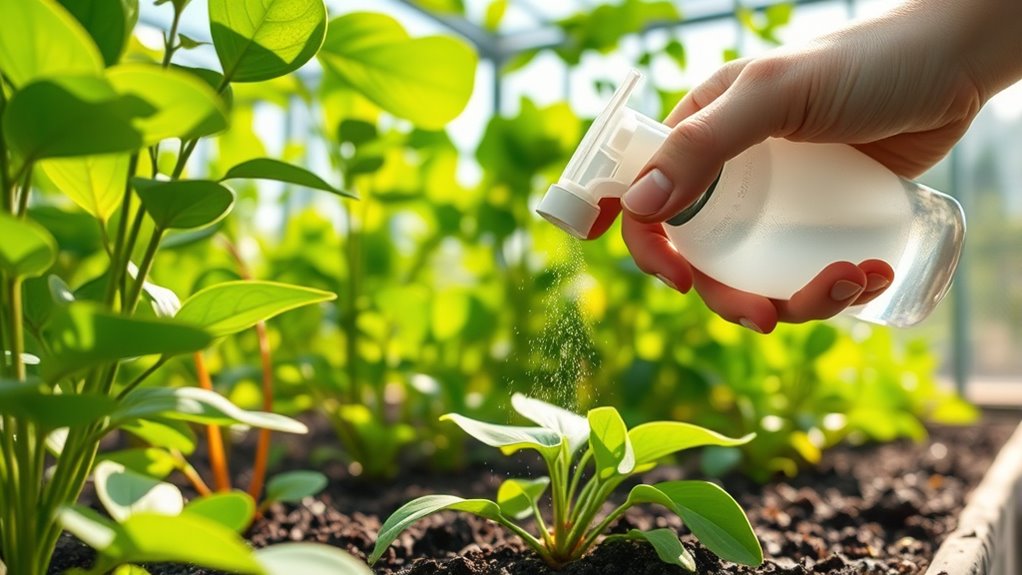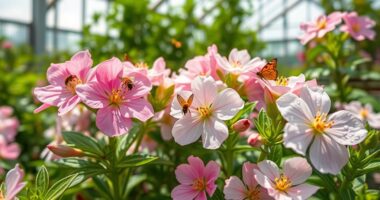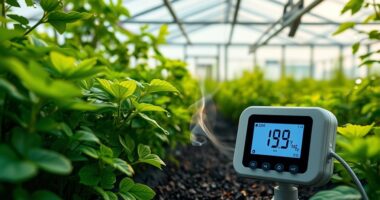To effectively feed your greenhouse plants, focus on providing the right nutrients through soil amendments and quick-acting fertilizers during active growth. Balance organic and synthetic options to improve soil structure and nutrient availability, and incorporate pest management to ensure plants absorb nutrients efficiently. Adjust fertilization based on plant needs and growth stages, avoiding overfeeding during dormancy. Continue exploring for detailed tips on creating a thriving, resilient greenhouse environment.
Key Takeaways
- Regularly assess plant needs and adjust fertilization during active growth and dormancy.
- Use organic or synthetic soil amendments to enhance nutrient availability and soil health.
- Incorporate pest management to prevent nutrient loss and promote healthy nutrient uptake.
- Apply water-soluble fertilizers for quick absorption and targeted nutrient delivery.
- Monitor for deficiency signs and tailor fertilization to support resilience and productivity.

Feeding your plants is vital for healthy growth and vibrant blooms. When you focus on proper fertilization, you give your plants the nutrients they need to thrive in your greenhouse environment. One of the key steps in guaranteeing optimal nutrition is understanding how to use soil amendments effectively. These amendments, whether organic or synthetic, improve soil structure, enhance nutrient availability, and promote vigorous root development. Adding compost, peat moss, or specific mineral supplements can boost the soil’s capacity to supply essential elements like nitrogen, phosphorus, and potassium. By regularly incorporating soil amendments, you help your plants access a steady stream of nutrients, which encourages lush foliage, strong stems, and abundant flowering. Additionally, understanding the role of soil amendments can help you tailor your fertilization strategy more effectively.
But healthy plants are not just about feeding; pest management also plays a vital role. Pests can quickly compromise your plants’ health, stealing nutrients and spreading disease, which undermines your fertilization efforts. To keep pests at bay, integrate pest management strategies into your overall plant care routine. This might include introducing beneficial insects, using organic sprays, or employing physical barriers to prevent pest access. When pests are controlled, your plants can absorb and utilize nutrients more efficiently, ensuring that your fertilization efforts translate into visible growth and blooms rather than battling infestations. Combining pest management with soil amendments creates a balanced approach that maximizes plant health and reduces the risk of disease or nutrient deficiencies.
Timing is equally important. You should assess your plants’ needs regularly and adjust your fertilization schedule accordingly. During active growth phases, your plants demand more nutrients, so you might need to apply soil amendments more frequently or use water-soluble fertilizers for quick absorption. Conversely, during dormant periods, reduce feeding to prevent over-fertilization, which can weaken plants or lead to salt build-up in the soil. Always monitor your plants for signs of nutrient deficiencies, such as pale leaves or stunted growth, and respond with targeted amendments to correct these issues promptly. Proper fertilization combined with vigilant pest management ensures your plants remain resilient, vibrant, and productive throughout their growth cycle.
Frequently Asked Questions
How Often Should I Test My Greenhouse Soil for Nutrients?
You should test your greenhouse soil for nutrients at least once every 4 to 6 weeks, especially during active growing seasons. Regular soil testing helps you monitor nutrient levels and identify deficiencies early. By doing nutrient monitoring consistently, you can adjust your fertilization schedule accordingly, ensuring your plants get the right nutrients. This proactive approach keeps your greenhouse healthy and boosts plant growth effectively.
What Are Signs of Nutrient Deficiencies in Greenhouse Plants?
Did you know that over 50% of greenhouse plant issues stem from nutrient deficiencies? You’ll notice plant leaf discoloration, such as yellowing or browning, and stunted growth when nutrients are lacking. These signs indicate your plants aren’t getting what they need. Keep a close eye on their color and size, and respond quickly with proper fertilization to keep your greenhouse thriving and healthy.
Can I Over-Fertilize and Damage My Plants?
You might wonder if you can over-fertilize your plants, and yes, fertilizer overdose can cause plant toxicity. When you give too much fertilizer, it stresses your plants, leading to nutrient imbalances, root damage, and yellowing leaves. To avoid this, follow recommended application rates and monitor your plants for signs of overfeeding. Proper fertilization guarantees healthy growth without risking plant toxicity or long-term damage.
Which Fertilizers Are Best for Organic Greenhouse Gardening?
Choosing the right fertilizers is like selecting the perfect recipe for a healthy garden. For organic greenhouse gardening, you should consider using compost tea and organic amendments, which nourish plants naturally. These fertilizers enrich the soil without synthetic chemicals, promoting vigorous growth. You’ll want to regularly apply compost tea, which acts as a liquid fertilizer, and incorporate organic amendments like compost or manure to guarantee your plants thrive in a sustainable way.
How Do Temperature and Humidity Affect Fertilization Effectiveness?
Temperature fluctuations and humidity control play vital roles in fertilization effectiveness. When temperatures vary, nutrient absorption slows or speeds up, so maintaining stable conditions helps your plants uptake nutrients efficiently. High humidity can dilute fertilizers or cause runoff, reducing their effectiveness. By controlling humidity levels, you guarantee nutrients stay available to your plants. Keep temperatures steady and humidity balanced to maximize fertilization benefits and promote healthy growth in your greenhouse.
Conclusion
Feeding your plants properly can boost their growth and health considerably. Did you know that plants receiving ideal fertilization can grow up to 30% faster than those without? By understanding your plants’ needs and applying the right nutrients at the right time, you’ll enjoy healthier, more vibrant greenhouse blooms and foliage. Keep experimenting and observing, and you’ll master the art of successful fertilization. Your plants will thank you with lush, thriving growth!









